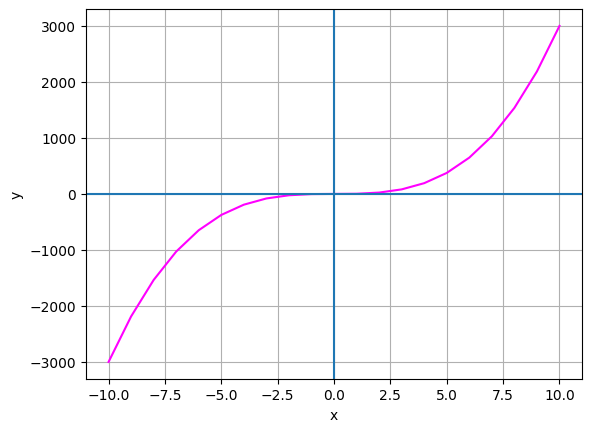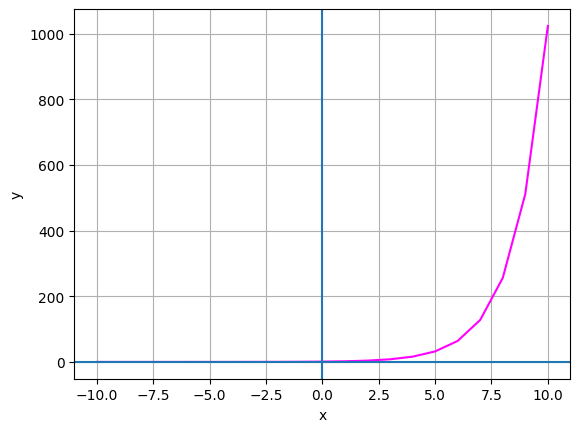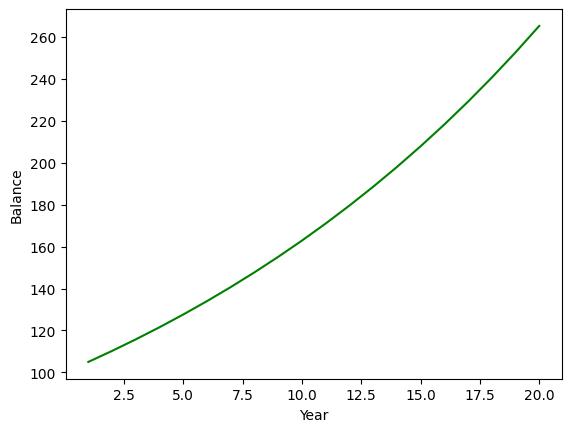Exponentials, Radicals, and Logs#
Up to this point, all of our equations have included standard arithmetic operations, such as division, multiplication, addition, and subtraction. Many real-world calculations involve exponential values in which numbers are raised by a specific power.
Exponentials#
A simple case of of using an exponential is squaring a number; in other words, multipying a number by itself. For example, 2 squared is 2 times 2, which is 4. This is written like this:
Similarly, 2 cubed is 2 times 2 times 2 (which is of course 8):
In Python, you use the ** operator, like this example in which x is assigned the value of 5 raised to the power of 3 (in other words, 5 x 5 x 5, or 5-cubed):
x = 5**3 # cube
print(x)
125
Multiplying a number by itself twice or three times to calculate the square or cube of a number is a common operation, but you can raise a number by any exponential power. For example, the following notation shows 4 to the power of 7 (or 4 x 4 x 4 x 4 x 4 x 4 x 4), which has the value:
In mathematical terminology, 4 is the base, and 7 is the power or exponent in this expression.
Radicals (Roots)#
While it’s common to need to calculate the solution for a given base and exponential, sometimes you’ll need to calculate one or other of the elements themselves. For example, consider the following expression:
This expression is asking, given a number (9) and an exponent (2), what’s the base? In other words, which number multipled by itself results in 9? This type of operation is referred to as calculating the root, and in this particular case it’s the square root (the base for a specified number given the exponential 2). In this case, the answer is 3, because 3 x 3 = 9. We show this with a √ symbol, like this:
Other common roots include the cube root (the base for a specified number given the exponential 3). For example, the cube root of 64 is 4 (because 4 x 4 x 4 = 64). To show that this is the cube root, we include the exponent 3 in the √ symbol, like this:
We can calculate any root of any non-negative number, indicating the exponent in the √ symbol.
The math package in Python includes a sqrt function that calculates the square root of a number. To calculate other roots, you need to reverse the exponential calculation by raising the given number to the power of 1 divided by the given exponent:
import math
# Calculate square root of 25
x = math.sqrt(25)
print (x)
# Calculate cube root of 64
cr = round(64 ** (1 / 3))
print(cr)
5.0
4
The code used in Python to calculate roots other than the square root reveals something about the relationship between roots and exponentials. The exponential root of a number is the same as that number raised to the power of 1 divided by the exponential. For example, consider the following statement:
Note that a number to the power of 1/3 is the same as the cube root of that number.
Based on the same arithmetic, a number to the power of 1/2 is the same as the square root of the number:
You can see this for yourself with the following Python code:
import math
print (9**0.5)
print (math.sqrt(9))
3.0
3.0
Logarithms#
Another consideration for exponential values is the requirement occassionally to determine the exponent for a given number and base. In other words, how many times do I need to multiply a base number by itself to get the given result. This kind of calculation is known as the logarithm.
For example, consider the following expression:
In other words, to what power must you raise 4 to produce the result 16?
The answer to this is 2, because 4 x 4 (or 4 to the power of 2) = 16. The notation looks like this:
In Python, you can calculate the logarithm of a number using the log function in the math package, indicating the number and the base:
import math
x = math.log(16, 4)
print(x)
2.0
The final thing you need to know about exponentials and logarithms is that there are some special logarithms:
The common logarithm of a number is its exponential for the base 10. You’ll occassionally see this written using the usual log notation with the base omitted:
Another special logarithm is something called the natural log, which is a exponential of a number for base e, where e is a constant with the approximate value 2.718. This number occurs naturally in a lot of scenarios, and you’ll see it often as you work with data in many analytical contexts. For the time being, just be aware that the natural log is sometimes written as ln:
The math.log function in Python returns the natural log (base e) when no base is specified. Note that this can be confusing, as the mathematical notation log with no base usually refers to the common log (base 10). To return the common log in Python, use the math.log10 function:
import math
# Natural log of 29 (exponent as e i.e. 2.71828)
print (f"Natural Log of 29: {math.log(29)}")
# Common log of 100 (exponent as 10)
print(f"Common Log of 100: {math.log10(100)}")
Natural Log of 29: 3.367295829986474
Common Log of 100: 2.0
Solving Equations with Exponentials#
OK, so now that you have a basic understanding of exponentials, roots, and logarithms; let’s take a look at some equations that involve exponential calculations.
Let’s start with what might at first glance look like a complicated example, but don’t worry - we’ll solve it step-by-step and learn a few tricks along the way:
First, let’s deal with the fraction on the right side. The numerator of this fraction is x2 + 2x2 - so we’re adding two exponential terms. When the terms you’re adding (or subtracting) have the same exponential, you can simply add (or subtract) the coefficients. In this case, x2 is the same as 1x2, which when added to 2x2 gives us the result 3x2, so our equation now looks like this:
Now that we’ve condolidated the numerator, let’s simplify the entire fraction by dividing the numerator by the denominator. When you divide exponential terms with the same variable, you simply divide the coefficients as you usually would and subtract the exponential of the denominator from the exponential of the numerator. In this case, we’re dividing 3x2 by 1x3: The coefficient 3 divided by 1 is 3, and the exponential 2 minus 3 is -1, so the result is 3x-1, making our equation:
So now we’ve got rid of the fraction on the right side, let’s deal with the remaining multiplication. We need to multiply 3x-1 by 2x4. Multiplication, is the opposite of division, so this time we’ll multipy the coefficients and add the exponentials: 3 multiplied by 2 is 6, and -1 + 4 is 3, so the result is 6x3:
We’re in the home stretch now, we just need to isolate y on the left side, and we can do that by dividing both sides by 2. Note that we’re not dividing by an exponential, we simply need to divide the whole 6x3 term by two; and half of 6 times x3 is just 3 times x3:
Now we have a solution that defines y in terms of x. We can use Python to plot the line created by this equation for a set of arbitrary x and y values:
import pandas as pd
# Create a dataframe with an x column containing values from -10 to 10
df = pd.DataFrame ({'x': range(-10, 11)})
# Add a y column by applying the slope-intercept equation to x
df['y'] = 3*df['x']**3
#Display the dataframe
print(df)
# Plot the line
%matplotlib inline
from matplotlib import pyplot as plt
plt.plot(df.x, df.y, color="magenta")
plt.xlabel('x')
plt.ylabel('y')
plt.grid()
plt.axhline()
plt.axvline()
plt.show()
x y
0 -10 -3000
1 -9 -2187
2 -8 -1536
3 -7 -1029
4 -6 -648
5 -5 -375
6 -4 -192
7 -3 -81
8 -2 -24
9 -1 -3
10 0 0
11 1 3
12 2 24
13 3 81
14 4 192
15 5 375
16 6 648
17 7 1029
18 8 1536
19 9 2187
20 10 3000

Note that the line is curved. This is symptomatic of an exponential equation: as values on one axis increase or decrease, the values on the other axis scale exponentially rather than linearly.
Let’s look at an example in which x is the exponential, not the base:
We can still plot this as a line:
import pandas as pd
# Create a dataframe with an x column containing values from -10 to 10
df = pd.DataFrame ({'x': range(-10, 11)})
# Add a y column by applying the slope-intercept equation to x
df['y'] = 2.0**df['x']
#Display the dataframe
print(df)
# Plot the line
%matplotlib inline
from matplotlib import pyplot as plt
plt.plot(df.x, df.y, color="magenta")
plt.xlabel('x')
plt.ylabel('y')
plt.grid()
plt.axhline()
plt.axvline()
plt.show()
x y
0 -10 0.000977
1 -9 0.001953
2 -8 0.003906
3 -7 0.007812
4 -6 0.015625
5 -5 0.031250
6 -4 0.062500
7 -3 0.125000
8 -2 0.250000
9 -1 0.500000
10 0 1.000000
11 1 2.000000
12 2 4.000000
13 3 8.000000
14 4 16.000000
15 5 32.000000
16 6 64.000000
17 7 128.000000
18 8 256.000000
19 9 512.000000
20 10 1024.000000

Note that when the exponential is a negative number, Python reports the result as 0. Actually, it’s a very small fractional number, but because the base is positive the exponential number will always positive. Also, note the rate at which y increases as x increases - exponential growth can be be pretty dramatic.
So what’s the practical application of this?
Well, let’s suppose you deposit $100 in a bank account that earns 5% interest per year. What would the balance of the account be in twenty years, assuming you don’t deposit or withdraw any additional funds?
To work this out, you could calculate the balance for each year:
After the first year, the balance will be the initial deposit ($100) plus 5% of that amount:
Another way of saying this is:
At the end of year two, the balance will be the year one balance plus 5%:
Note that the interest for year two, is the interest for year one multiplied by itself - in other words, squared. So another way of saying this is:
It turns out, if we just use the year as the exponent, we can easily calculate the growth after twenty years like this:
Let’s apply this logic in Python to see how the account balance would grow over twenty years:
import pandas as pd
# Create a dataframe with 20 years
df = pd.DataFrame ({'Year': range(1, 21)})
# Calculate the balance for each year based on the exponential growth from interest
df['Balance'] = 100 * (1.05**df['Year'])
#Display the dataframe
print(df)
# Plot the line
%matplotlib inline
from matplotlib import pyplot as plt
plt.plot(df.Year, df.Balance, color="green")
plt.xlabel('Year')
plt.ylabel('Balance')
plt.show()
Year Balance
0 1 105.000000
1 2 110.250000
2 3 115.762500
3 4 121.550625
4 5 127.628156
5 6 134.009564
6 7 140.710042
7 8 147.745544
8 9 155.132822
9 10 162.889463
10 11 171.033936
11 12 179.585633
12 13 188.564914
13 14 197.993160
14 15 207.892818
15 16 218.287459
16 17 229.201832
17 18 240.661923
18 19 252.695020
19 20 265.329771

